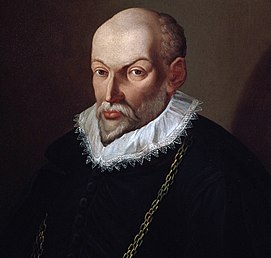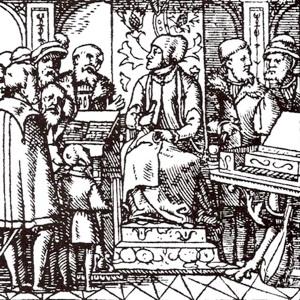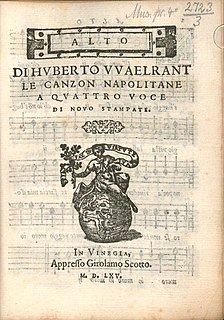External links
- Free scores by Gerardus Mes in the Choral Public Domain Library (ChoralWiki)
Gerardus Mes or Gherardus (fl. c. 1561) was a Franco-Flemish composer.
Little of his work has survived, except the settings for four voices of the Souterliedekens , 150 Dutch Psalm Songs and canticles, possibly written by nobleman Willem van Zuylen van Nijevelt and published in 1540 with a notation of the melody for one voice. Mes's settings appeared in Antwerp in 1561 as the eighth up to the eleventh volume of the Musijck Boexkens, a collection of Dutch songs edited by Tielman Susato. In this series, Susato had already published Jacobus Clemens non-Papa's Psalm settings for three voices in 1556-57.
As was already the case with the Dutch secular songs from Susato's Ierste and Tweetste Musijck Boexken (first and second Music Book), performance with human voices as well as with instruments is suggested in the edition of Mes's Psalm settings. On the title page of the Souterliedekens, Mes is also mentioned as a pupil of Clemens non-Papa, which is the only fact we know about his life. Of his Souterliedekens, no complete copy has survived; the bass voice is missing.
In his Souterliedekens, Mes made use of several writing techniques: sometimes, he used the original tune of a Psalm Song from the collection published in 1540 in the soprano voice (while Clemens used the tunes in the tenor voice); sometimes he wrote an entirely new composition, in which now and then was initially borrowed from the original tune whereupon the composition goes its own way. In a number of cases, Mes used an existing tune, but another one as Clemens did. Mes's Souterliedekens were apparently still popular in the seventeenth century; some of them were used by the Delft priest and poet Stalpart van der Wiele. An attempt to reconstruct the Souterliedekens's missing bass voice, was undertaken by Louis Peter Grijp.
Apart from his Souterliedekens, only one other piece of music by Mes has survived; a motet.

Orlande de Lassus was a composer of the late Renaissance. The chief representative of the mature polyphonic style in the Franco-Flemish school, Lassus stands with Giovanni Pierluigi da Palestrina and Tomás Luis de Victoria as the leading composers of the later Renaissance. Immensely prolific, his music varies considerably in style and genres, which gave him unprecedented popularity throughout Europe.
Jacobus Clemens non Papa was a Netherlandish composer of the Renaissance based for most of his life in Flanders. He was a prolific composer in many of the current styles, and was especially famous for his polyphonic settings of the psalms in Dutch known as the Souterliedekens.
Nicolas Gombert was a Franco-Flemish composer of the Renaissance. He was one of the most famous and influential composers between Josquin des Prez and Palestrina, and best represents the fully developed, complex polyphonic style of this period in music history.

TielmanSusato was a Renaissance composer, instrumentalist and publisher of music in Antwerp.

Claude Le Jeune was a Franco-Flemish composer of the late Renaissance. He was the primary representative of the musical movement known as musique mesurée, and a significant composer of the "Parisian" chanson, the predominant secular form in France in the latter half of the 16th century. His fame was widespread in Europe, and he ranks as one of the most influential composers of the time.
Jacobus Vaet was a Flemish composer of the Renaissance. He was a representative of the generation between Josquin and Palestrina, writing smooth polyphony with pervasive imitation, and he was a friend both of Clemens non Papa and Lassus.
The Souterliedekens is a Dutch metrical psalter, published in 1540 in Antwerp, and which remained very popular throughout the century. The metrical rhyming psalms were, probably, arranged by a Utrecht nobleman: Willem van Zuylen van Nijevelt. For the melodies he used folksongs from the Low Countries. This publication has great value, because the publisher not only added the phrase 'sung to the tune of...' but also provided the actual music (melody) with the texts.
Antoine de Bertrand was a French composer of the Renaissance. Early in his life he was a prolific composer of secular chansons, and late in his life he wrote hymns and canticles, under the influence of the Jesuits. He was murdered by Protestants during the French Wars of Religion.
Dominique Phinot was a Franco-Flemish composer of the Renaissance, active in Italy and southern France. He was highly regarded at the time for his motets, which anticipate the style of Palestrina, and in addition he was an early pioneer of polychoral writing.

The Genevan Psalter, also known as The Huguenot Psalter, is a metrical psalter in French created under the supervision of John Calvin for liturgical use by the Reformed churches of the city of Geneva in the sixteenth century.

Hubert Waelrant or Hubertus Waelrant was a Flemish composer, singer, teacher, music editor, bookseller, printer and publisher active in 16th century Antwerp. He was a member of the generation of the Franco-Flemish School of composers who were contemporaries of Palestrina. Unlike famous composers of his time he mostly worked in northern Europe. His style is a transition between that of Nicolas Gombert and the mature Orlande de Lassus. His compositions were modern in the use of chromaticism and dissonance.

Lodewijk de Bisschop, latinised as Ludovicus Episcopius was a Flemish Roman Catholic priest and composer of the late Renaissance and one of the first to compose secular songs in the Dutch language.
Tandernaken, al op den Rijn was once a very popular Middle Dutch song about two girls who in Andernach, a city in Germany on the left Rhine bank, were spied on by the lover of one of the girls, who was listening to their conversation on love affairs from a distance.
Philippe Rogier was a Franco-Flemish composer of the Renaissance, active at the Habsburg court of Philip II in Spain. He was one of the last members of the Franco-Flemish school, in the closing days of the Renaissance period in music history, and was a prolific composer; however most of his music was lost in the destruction by fire of the library of John IV during the Lisbon earthquake of 1755.

Camerata Trajectina is a Dutch early music ensemble.
Martin Peudargent was a Flemish composer and chapel master of William, Duke of Jülich-Cleves-Berg in Düsseldorf.

"Was mein Gott will, das g'scheh allzeit" is a Lutheran hymn in German. The text from c. 1550 is attributed to Albert, Duke of Prussia. The melody, Zahn No. 7568, goes back to a tune by Claudin de Sermisy, written in 1529 for a secular French song. The hymn has belonged to core Lutheran hymnody without interruption and is part of the Protestant hymnal Evangelisches Gesangbuch as EG 364.

Jacob Bathen or Jacob Baethen, Latinised as Jacobus Bathius, Iacobus Batius and Jacobus Bathenius, was a Flemish bookseller, printer and publisher of the 16th century, mainly known now for music publications. He is sometimes confused with Johannes Baethen, a printer active in Leuven and Cologne between 1552 and 1562, who was likely his brother. Jacob was active in Leuven, Maastricht and Düsseldorf. He is mainly remembered for his publication of the so-called Maastricht songbook of 1554, which is one of only five surviving song books in the Dutch language from the 16th century.